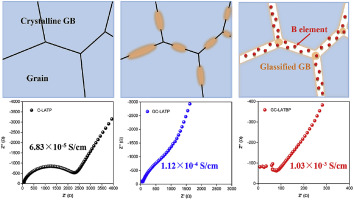Journal of Power Sources ( IF 9.2 ) Pub Date : 2019-12-11 , DOI: 10.1016/j.jpowsour.2019.227574 Shanshan Duan , Junxi Yu , Yuanwei Sun , Aolin Li , Shulin Chen , Ke Qu , Zhengping Ding , Zixian Liu , Yuhang Li , Can Huang , Min Liu , Jiale Liu , Jianpeng Shi , Boyuan Huang , Xiaocong Tian , Shuen Hou , Shuhong Xie , Yunya Liu , Peng Gao , Jiangyu Li , Hongyun Jin

|
Glass-ceramic electrolytes are promising for all-solid-state batteries, yet their enhanced ionic conductivity is not well understood. We investigate structural difference between ceramic and glass-ceramic Li1.3Al0.3Ti1.7(PO4)3 tuned by boron, which is found to enhance conductivities of glass-ceramics by one order of magnitude, yet reduces that of ceramics. Raman and Magic Angle Spinning Nuclear Magnetic Resonance spectra indicate boron are primarily contained in glass phase, while electron energy-loss spectroscopy and high-resolution transmission electron microscopy reveal inhomogeneous distribution of boron and glassified grain boundaries. This substantially reduces interfacial resistance at grain boundaries with little effect on bulk resistance, which is further supported by spatial and spectroscopic electrochemical strain microscopy. The grain boundary resistance of ceramics, on the other hand, is increased by boron. We thus establish that lower interfacial resistance at glassified grain boundaries is responsible for higher conductivity in glass-ceramics, while boron can relax their grain boundaries even further.
中文翻译:

选择性掺杂以放松玻璃化的晶界,从而大大增强了LiTi 2(PO 4)3玻璃陶瓷电解质的离子电导率
玻璃陶瓷电解质有望用于全固态电池,但其增强的离子电导率尚未得到很好的理解。我们研究陶瓷和玻璃陶瓷Li 1.3 Al 0.3 Ti 1.7(PO 4)3之间的结构差异通过硼进行调谐,发现硼可将玻璃陶瓷的电导率提高一个数量级,但会降低陶瓷的电导率。拉曼和魔角自旋核磁共振光谱表明硼主要包含在玻璃相中,而电子能量损失谱和高分辨率透射电子显微镜显示硼和玻璃化晶界的不均匀分布。这大大降低了晶界处的界面电阻,而对体积电阻几乎没有影响,这进一步得到了空间和光谱电化学应变显微镜的支持。另一方面,硼会增加陶瓷的晶界电阻。因此,我们确定玻璃陶瓷晶界处较低的界面电阻是玻璃陶瓷中较高的电导率的原因,



























 京公网安备 11010802027423号
京公网安备 11010802027423号